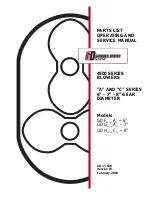
9
rotor blades strike the ground. The wheels do not
have to touch the ground in order to self-propel.
The further you tilt the handle forward, the faster
the snowthrower self-propels. However, depth
and height of snow affects forward speed.
Always overlap each swath and discharge
downwind when possible.
Note:
If snowthrower is tilted too far
forward, it will self–propel at a rapid
rate and snow will spray back at the
feet of the operator. Reduce lift on
handle slightly to self–propel at a
moderate rate.
3.
Keep the area to be cleared free of stones, toys,
or other foreign objects which may be picked up
and thrown by the rotor blades. Such items could
be covered by snowfall and, therefore, unnoticed
until struck by the rotor blades. Always be sure
to keep all people and pets away from area of
operation to prevent possibility of being hit by
thrown objects.
4.
ON STEPS OR CUTTING THROUGH
DRIFTS— It is recommended that operator
stand on right side of snowthrower and hold it
by upper handle and chute handle (standing on
left side may expose operator to engine exhaust).
Use a side–to–side sweeping motion to clear
snow.
5.
It is not recommended that snowthrower be used
on gravel or crushed rock driveways or walks.
Should you find it necessary to clear snow from
crushed rock or gravel, push down on handle to
raise rotor blades clear of loose material that
could be thrown by the blades and push unit
forward.
6.
In some snow and cold weather conditions, some
controls and moving parts may freeze solid. DO
NOT USE EXCESSIVE FORCE WHEN
TRYING TO OPERATE FROZEN
CONTROLS. When any control or part
becomes hard to operate, start the engine and let
it run for a few minutes. If control or part still
will not move with moderate force, stop engine,
remove ice or thaw out snowthrower.
POTENTIAL HAZARD
•
Gasoline and its fumes are highly
flammable, explosive, and dangerous if
inhaled.
WHAT CAN HAPPEN
•
If gasoline contacts a flame or is inhaled,
serious personal injury can occur.
HOW TO AVOID THE HAZARD
•
Never warm up snowthrower with fuel in
tank inside a building where open flame or
sparks are present.
•
Never store snowthrower in house (living
area), basement or anywhere open flame is
present.
7.
AFTER CLEARING SNOW—Let engine run
for a few minutes so ice does not freeze moving
parts solid. After engine is shut off, wipe ice and
snow off entire unit.
IMPORTANT: STORE SNOWTHROWER
IN OPERATING POSITION ON ITS
WHEELS OR HANG ON A WALL BY ITS
HANDLE. TIPPING OR STORING UNIT
FORWARD ONTO FRONT HOUSING MAY
CAUSE HARD STARTING.
Folding Snowthrower (Fig. 7)
The CCR POWERLITE
folds compactly for easy
transporting or storage. To fold up snowthrower,
follow these instructions:





































